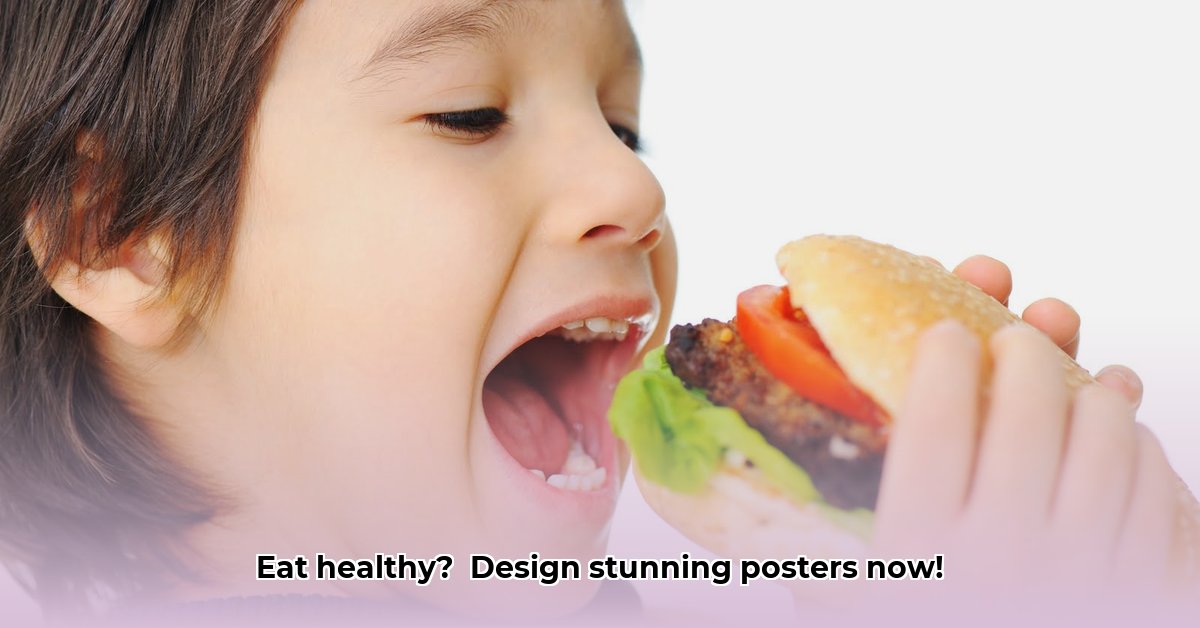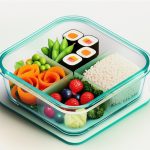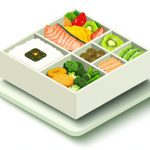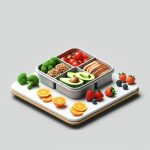Are you ready to inspire healthier eating habits with impactful, visually engaging posters? This comprehensive guide provides a roadmap for crafting “eat healthy” posters that capture attention and motivate positive change across diverse audiences. Whether for schools, workplaces, community centers, or your own home, you’ll learn how to create posters that resonate with children, teens, adults, and individuals with specific dietary requirements. This guide covers key design strategies, readily available tools and resources, and methods for assessing the impact of your work. For more tips on healthy eating, check out this helpful resource. Let’s create posters that deliver real, measurable results!
Designing for Impact: A Step-by-Step Guide to Effective “Eat Healthy” Posters
Creating a truly effective “eat healthy” poster requires a strategic approach that combines compelling visuals with clear, concise messaging. This step-by-step guide will help you design posters that grab attention, communicate essential information, and promote lasting positive change.
1. Understanding Your Audience: The Key to Resonance
Before you begin designing, take the time to thoroughly understand your target audience. A poster’s effectiveness hinges on its ability to resonate with the intended viewers. Consider factors such as:
- Age: Design considerations will vary significantly depending on whether you’re targeting young children, teenagers, adults, or seniors.
- Literacy Level: Use clear, simple language that is easily understood by all members of your target audience.
- Cultural Background: Ensure that your visuals and messaging are culturally sensitive and appropriate for the community you’re trying to reach.
- Dietary Needs: If you’re targeting individuals with specific dietary needs (e.g., diabetes, allergies), make sure to include relevant information and guidance.
- Existing Knowledge: Gauge the current level of understanding about healthy eating within your audience. This will help you tailor your message appropriately.
For example, a poster designed for young children might feature colorful cartoon characters and simple messages about the benefits of eating fruits and vegetables. A poster designed for adults, on the other hand, might focus on the long-term health benefits of a balanced diet and include more detailed nutritional information.
2. Design for Engagement: Capturing Attention and Delivering Your Message
Once you understand your audience, you can begin to design a poster that will capture their attention and effectively communicate your message. Consider these key design elements:
- Color Palette: Colors evoke emotions and influence perception. Use bright, vibrant colors to attract attention and create a positive association with healthy foods. Consider color psychology when making your selections. For instance:
- Green: Often associated with health, nature, and freshness.
- Yellow: Can evoke feelings of happiness, energy, and optimism.
- Orange: Combines the energy of red with the happiness of yellow, often associated with vitality and good health.
- Red: Can be used sparingly to draw attention to key information.
- Typography: Select fonts that are easy to read from a distance. Avoid overly decorative or stylized fonts that can be difficult to decipher. Use a clear hierarchy of fonts to highlight important information.
- Imagery: Use high-quality, appealing images of healthy foods. Consider using photos of real people enjoying healthy meals. Visuals should be relevant to your target audience and culturally appropriate.
- Layout and Composition: Create a clean, organized layout that is easy to follow. Use white space effectively to avoid clutter and create visual breathing room. Ensure that the most important information is prominently displayed.
- Call to Action: Include a clear and concise call to action that tells viewers what you want them to do (e.g., “Eat more fruits and vegetables,” “Choose water over sugary drinks,” “Make healthy choices today!”).
3. Tools and Resources: Empowering Your Creativity
Numerous tools and resources are available to help you create professional-looking “eat healthy” posters, regardless of your design experience:
- Canva: A user-friendly online design platform with a wide range of templates and design elements. Canva offers both free and paid plans.
- Adobe Creative Cloud Express (formerly Adobe Spark): Another excellent online design tool with a focus on ease of use.
- PicMonkey: A photo editing and design platform that offers a variety of tools for creating visually appealing posters.
- Piktochart: A platform specializing in creating infographics and other visual content, ideal for presenting nutritional information in an engaging format.
- Free Stock Photo Websites: Websites like Unsplash, Pexels, and Pixabay offer a vast library of high-quality, royalty-free images that you can use in your posters.
- Nutrition.gov: Provides printable materials and handouts on various nutrition topics, which can serve as inspiration or content for your posters.
While templates can provide a helpful starting point, remember to personalize your poster to make it unique and resonate with your target audience.
4. Measuring Impact: Assessing Effectiveness and Driving Improvement
While quantifying the direct impact of a poster on behavior change can be challenging, several methods can provide valuable insights into its effectiveness:
- Surveys and Questionnaires: Conduct brief surveys or questionnaires before and after displaying the poster to assess changes in knowledge, attitudes, and behaviors related to healthy eating.
- Observation: Observe how people interact with the poster. Do they stop to read it? Do they seem engaged with the message?
- Focus Groups: Conduct focus groups to gather in-depth feedback on the poster’s design, messaging, and overall impact.
- Website Analytics: If you’re promoting the poster online, track website traffic and social media engagement to gauge its reach and impact.
- Anecdotal Evidence: Collect anecdotal evidence from individuals who have seen the poster. Have they made any changes to their eating habits as a result?
- Sales Data: In a school or workplace setting, track the sales of healthy vs. unhealthy food options before and after displaying the poster.
By gathering data and feedback, you can identify areas for improvement and refine your poster designs to maximize their effectiveness.
5. Inspiration Gallery: Learning from Successful Examples
Examine successful “eat healthy” posters and campaigns to identify key design elements and messaging strategies that resonate with different audiences. Analyze their use of color, imagery, typography, and layout. Pay attention to how they tailor their message to specific demographics and dietary needs.
Here are some examples of effective poster designs:
- Posters that use humor: A clever and humorous approach can be very effective at capturing attention and making your message memorable.
- Posters that tell a story: A compelling narrative can engage viewers on an emotional level and inspire them to make healthier choices.
- Posters that showcase the benefits of healthy eating: Focus on the positive outcomes of healthy eating, such as increased energy, improved mood, and reduced risk of chronic disease.
- Posters that provide practical tips and advice: Offer actionable steps that viewers can take to improve their eating habits.
- Posters that feature testimonials from real people: Share stories of individuals who have successfully made positive changes to their diets.
By studying successful examples, you can gain valuable insights and inspiration for your own poster designs.
| Target Audience | Design Considerations | Possible Images/Style | Messaging Examples |
|---|---|---|---|
| Children (Ages 5-10) | Bright colors, simple and engaging images, large and playful fonts, short and concise messages, focus on fun and taste. | Cartoon characters enjoying fruits and vegetables, colorful illustrations of healthy meals, images of kids actively playing. | “Eat your colors!”, “Fruits and veggies give you superpowers!”, “Healthy food is yummy food!” |
| Teens (Ages 13-19) | Trendy and relatable visuals, focus on energy and well-being, infographics on nutrition, peer-to-peer messaging, connect to social media trends. | Active teens eating healthy snacks, images of healthy meals that are popular on social media, infographics on the benefits of healthy eating for athletic performance and mental clarity. | “Fuel your body, fuel your life!”, “Eat smart, feel great!”, “Healthy eating doesn’t have to be boring!” |
| Adults (Workplace) | Clean and professional design, concise and informative text, data-driven visuals, subtle and sophisticated imagery, focus on productivity and wellness. | Charts showing the benefits of healthy eating on energy levels and productivity, images of healthy meals that are easy to prepare and eat at work, infographics on portion control. | “Invest in your health, invest in your productivity!”, “Healthy employees are happy employees!”, “Make healthy choices, boost your career!” |
| Adults (General Public) | Appealing food photos, family-friendly imagery, inspiring messages, clear call to action, focus on taste and convenience. | Images of families enjoying healthy meals together, close-up shots of delicious and nutritious foods, easy-to-follow recipes. | “Eat well, live well!”, “Healthy eating made easy!”, “Discover the joy of healthy cooking!” |
| Diabetics | Simple and clear information, dietary guidelines, easy-to-read fonts, focus on portion control and blood sugar management. | Portion control plates, images of approved food lists for diabetics, infographics on the glycemic index. | “ |
- How Glass Bento Box Containers Make Meal Prep Easier - December 18, 2025
- Why Glass Boxes for Lunch Are Trending for Meal Prep - December 17, 2025
- Bento Box Glass Offers Practical, Eco-Friendly Meal Storage - December 16, 2025










